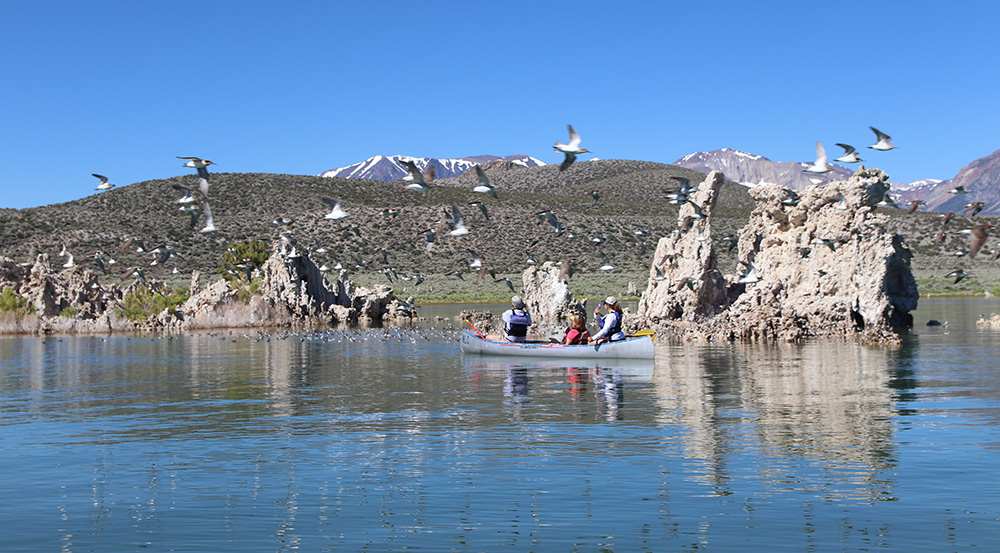
If you wanted to summarize this past summer at Mono Lake in one word it would be this: phalaropes.

The dainty Mono-loving migrators put on spectacular displays at South Tufa for many days, dipping and weaving in tight flocks of thousands. Visitors stopped in their tracks and canoes floated in place to watch the aerial acrobatics. Mono Lake Committee staff captured one dramatic episode on video and it quickly became our most-watched video ever; you can see it for yourself here.
The phalaropes have now headed to points south for the winter, but like many things at Mono Lake, their summer displays were possible thanks to protection work behind the scenes. New efforts to study the phalaropes are underway, highlighted by an exciting international meeting this past June. We hope to see them again next year at South Tufa—and perhaps be even more capable of studying their health and success as a species at Mono Lake.
Mono Lake grew in size over the summer, with the surface level rising a foot, just as forecast. The expectation is for another half-foot rise over the winter, leading to a net 1.5-foot year-to-year gain by April 1, 2020.
Now lake level thinking turns to the winter ahead. Will it be dry, average, or wet? The answer will be delivered by the unknown sequence of winter storms that awaits. As usual, it is prudent to plan for all possibilities. The good news is that the lake’s level is approaching the range where it was before the recent five-year drought. The landbridge to Negit Island has been broken into a small island, and even in a dry-year scenario the lake would not fall so far as to re-expose the pathway for coyotes to nesting gulls. The electric fence that worked so well to protect the gulls in 2017 will stay rolled up in storage in 2020.
Planning for next year also includes thinking about Mono Lake’s tributary streams. What flows will make their way down Rush, Lee Vining, Parker, and Walker creeks? There’s no question that the right answer is the new, science-based Stream Ecosystem Flows. These sophisticated flow patterns maximize restoration and habitat benefits on the creeks by enhancing channel structure, scouring pools for fish, and spreading seeds and sediment across the floodplain to rebuild riparian forests.
Earlier in 2019, the Committee was successful in advocating for these flows to govern Los Angeles Aqueduct operations this year and we expect the same for 2020. They will ultimately be part of the revised Los Angeles Department of Water & Power (DWP) license to divert water from the Mono Basin, but that process has taken so long that the Committee has pushed to implement the flows on an interim basis. DWP operated in 2019 under a temporary license change and had to tackle the new pattern of operating its diversion facilities. The results were fairly successful, although the new outlet slated for construction at Grant Lake Reservoir is still needed to deliver the full range of high flows to Rush Creek.
On Lee Vining Creek the new operating rules worked as designed to ensure that the high spring flow passed the diversion dam undiminished. Past attempts to deliver the peak flow to the creek were frequently unsuccessful as they required forecasting flow patterns and quick action to halt diversion operations. The new rules are more complex but deliver a simple result: as streamflow rises above 250 cubic feet per second (a significant flow level and a sign of a coming peak), diversions must be shut off. When flow falls below 250 cubic feet per second, diversions can resume following a detailed table designed to maximize restoration benefits in the stream as well.
Summer also brought significant progress on the task of revising DWP’s legal water licenses to include the provisions of the 2013 Mono Basin Stream Restoration Agreement reached by the Committee, DWP, the California Department of Fish & Wildlife, and CalTrout. The Agreement covers all the details of implementing the science-based next phase of stream restoration as required by the California State Water Resources Control Board.
Regular Newsletter readers know the process has been sidetracked by DWP for several years. The good news: the State Water Board has firmly redirected the process and DWP has submitted a timeline for completion of the environmental document that has held things up. That document is in final development now and will go out for public comment in January 2020, setting the stage for the entire process to wrap up by summer next year.
This is not the first timeline proposed in the last six years and Committee staff and attorneys are closely engaged to make sure the process stays on track to completion. To learn when important public comment opportunities happen please visit this page to be sure we have your current email address.
This post was also published as an article in the Fall 2019 Mono Lake Newsletter (page 2).
